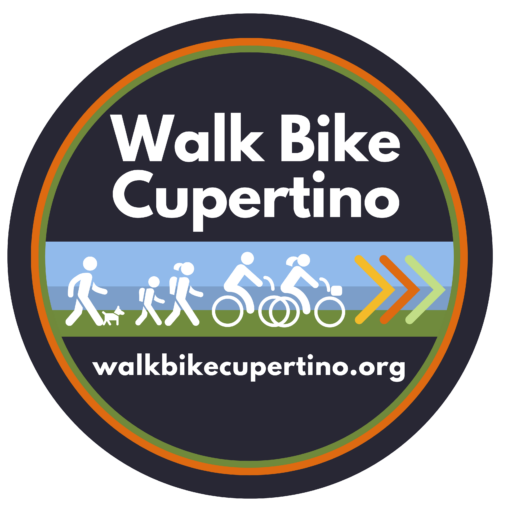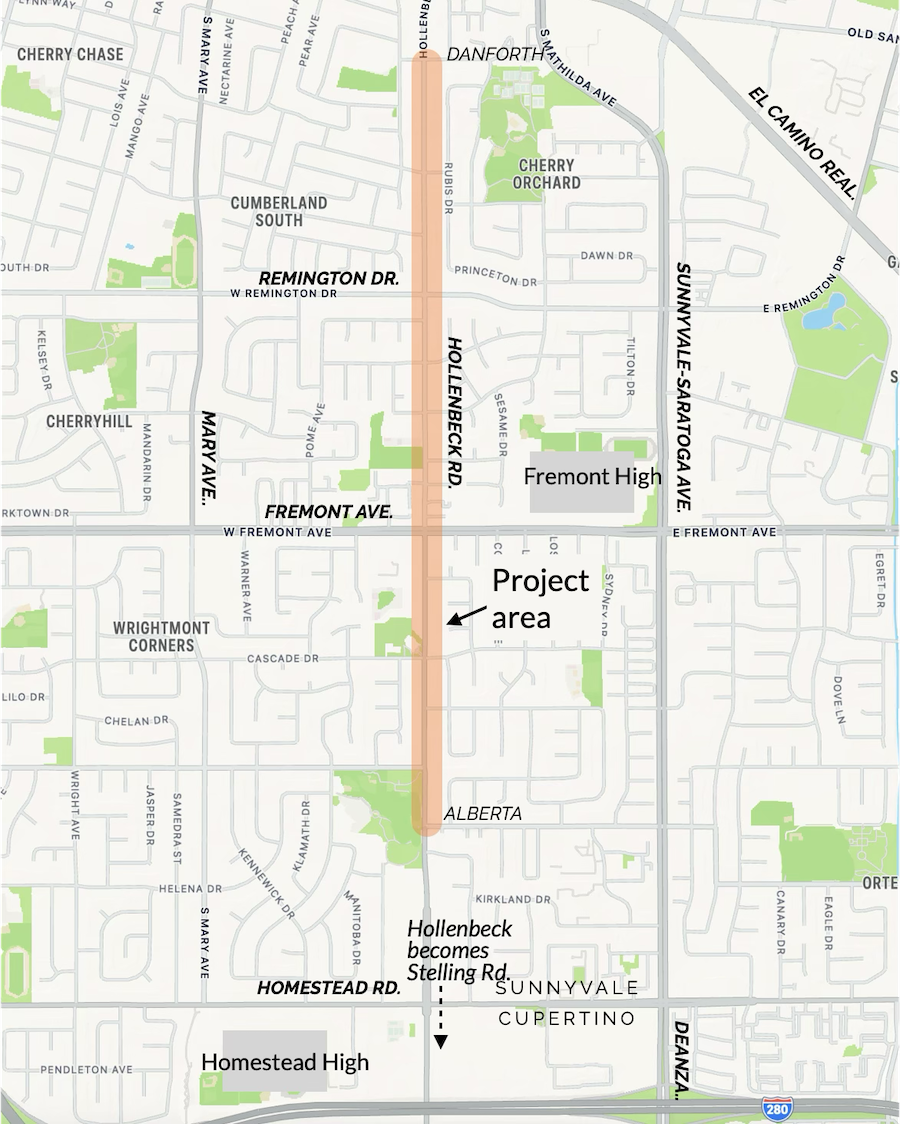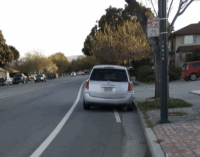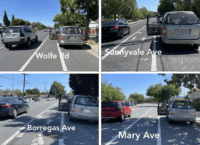Hollenbeck Avenue is a central north-south corridor that connects Cupertino’s Stelling Road to popular destinations in Sunnyvale, like Caltrain station, downtown, and Moffett Park (in conjunction with Pastoria, Sunnyvale Ave., and Borregas). Yet, unlike Stelling, Hollenbeck lacks bike lanes. The City of Sunnyvale is considering adding bike lanes to Hollenbeck in an effort to make biking on that street safer.
At a recent council study session, two potential bike lane configurations were discussed, but only one of them is safe. Alternative 1, buffered bike lanes and the removal of parking, is safe, but the Alternative 2 with unbuffered bike lanes adjacent to parking is not.
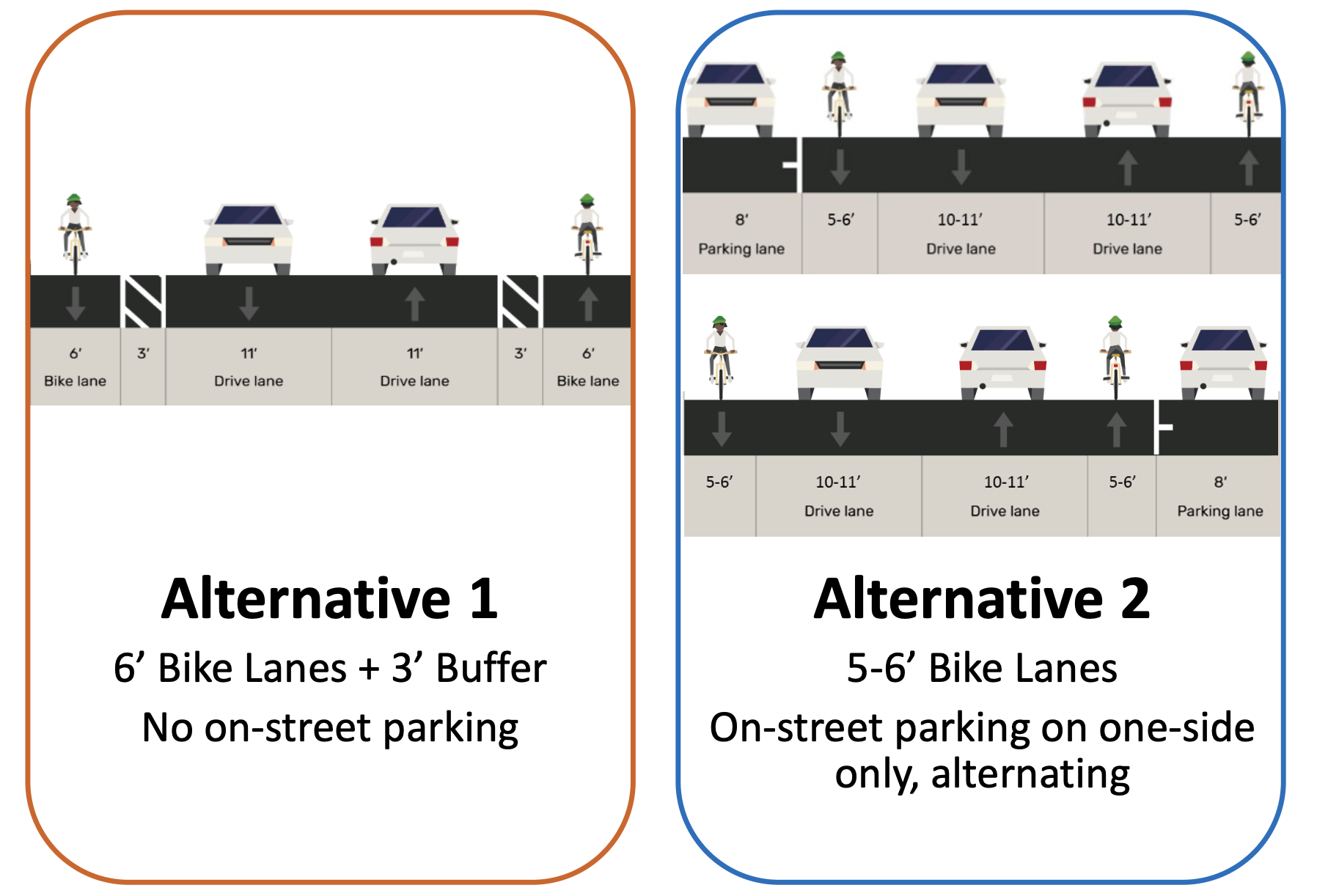
A Rock and a Hard Place
At first glance, Alternative 2 may seem like a good compromise between street parking and bike lanes, but in reality it severely compromises bike safety. Some argue that Alternative 2 is even more dangerous than having no bike lanes at all.
Like Wolfe Road’s bike lanes, Alternative 2 places an unbuffered bike lane between parked cars on the right and fast moving cars on the left. When opened, the parked car’s door spans almost all of the bike lane. Any opened door will crash into a passing cyclist, causing severe injury and death. [See this video of someone getting doored.] Children and other inexperienced cyclists are especially vulnerable in these zones, with door zone crashes happening at alarming rates. Sixteen percent of all San Francisco reported bike/car collisions are due to ‘dooring’, and there are higher rates in other similar cities. If more door bike lanes are implemented in Sunnyvale, likely the number of deaths and severe injuries will increase, too.
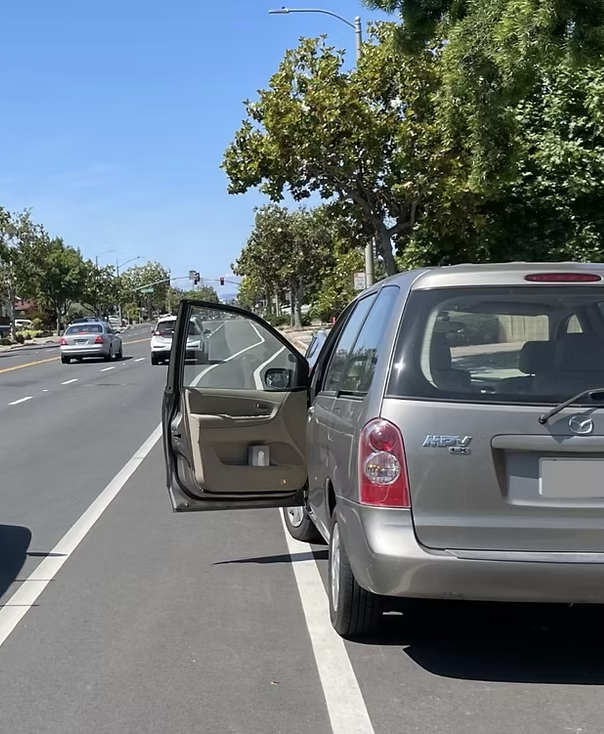
Any class II bike lanes with parking next to them present a danger.
Sunnyvale Council asks for other options
One council idea was to keep parking on one side consistently instead of zigzagging, and have the parking lane transition only at intersections. However, just like Alternative 2, these variations still feature door zone bike lanes, unbuffered on both sides, and do not satisfy the Caltrans Complete Streets Guidance.
Councilmember Mehlinger suggested a 2-way cycletrack on one side and parking on the other side. However, this idea would be much more expensive to implement than Alternative 1, substantially delaying the bike lanes, and would have a new safety hazard as drivers may not look both ways when backing out of the many driveways.
Sunnyvale already has city policies in place that prioritize safe bikeways over street parking. Time and money should not be spent retaining street parking, especially when parking usage isn’t very high in most locations, and Alternative 1’s buffered bike lanes will make cyclists safer than all the alternatives.
It’s important that the Sunnyvale Council determine if it’s possible to have a road configuration that simultaneously provides safe bikeways and retains parking. It is possible that it is infeasible on Hollenbeck to have parking and have safety for cyclists. In such a case, Councilmember Mehlinger pointed out that city policies prioritize safe bikeways over street parking. He does not support door zone bike lanes and other unsafe configurations.
Learn more below about key considerations
Alternative 2's Zigzagging Parking Lane is Hazardous to Cyclists
In Alternative 2’s zigzag design of the parking and travel lanes, drivers routinely and illegally park in the bike lane at parking zone transitions, causing cyclists to swerve into car traffic to get around them. Examples of illegally parked cars can be frequently seen on Mary Ave, Wolfe Rd, and everywhere else that parking zones have transitions. The zigzag design uses cyclists as the barrier between the car lane and the parking lane. Inattentive drivers and cyclists will crash into each other and into parked cars at zigs and zags in the road.
Alternative 2 Fails to Meet Caltrans Guidance
Recognizing the safety benefits of buffers and wider bike lanes, Caltrans issued the Complete Streets Guidance (DIB-94) in January 2024. Alternative 2 fails to meet Caltrans Guidance in the following ways. The Guidance specifies a 2′-4′ door zone buffer between the bike lane and parking lane (p. 28). In addition, it specifies a 2′-4′ buffer to the left of the bike lane to separate it from the car lane (p. 27). The Guidance also specifies a bike lane clear pavement width of 5′-7′ (p. 27). It specifies that unbuffered bike lanes should be used on roads no faster than 25 mph (p. 23). Alternative 2 fails all these specifications.
In contrast, Alternative 1 satisfies all of Caltrans Guidance.
Comparison to other Sunnyvale streets
The Alternative 2 design exists on other streets in Sunnyvale, for example, Wolfe, Sunnyvale Ave, Borregas, and Mary. Mayor Klein asked Staff to compare the Hollenbeck Alternative 2 design to these other streets. While understanding current designs is worthwhile, it is unwise to base future designs on today’s unsafe designs. None of today’s Alternative 2 designs meets Caltrans Complete Streets Guidance (DIB-94). The accompanying table summarizes the dimensions of Sunnyvale streets with parking to the right of a bike lane and sometimes a buffer to the left of the bike lane.
| street | parking | bike lane | buffer |
| Hollenbeck, Alt 2 | 8′ | 5′-6′ | 0′ |
| Wolfe | 7.5′ | 5′ | 0′ |
| Sunnyvale Ave | 7.5′ | 5′ | 1.5′ |
| Borregas | 8′ | 5′ | 2′ |
| Mary | 9′ | 6′ | 0′ |
Wolfe Rd is the closest to the Hollenbeck Alternative 2 design, with 7.5′ parking, 5′ bike lane, and no buffer. It has a severe door zone hazard. A parked car’s door spans most of the bike lane. Sunnyvale Ave and Borregas Ave both have a buffer to the left. The buffer, even if just 1.5′, provides much needed relief from the door zone. The widest street is Mary Ave, which has the widest parking lane and bike lane. Although it has no buffer, it feels roomy and a cyclist has some room to maneuver. However, all these streets rely on the cyclist to know to avoid the door zone.
Alternative 2 Disregards Sunnyvale Goals and Policies
In brief, city goals and policies prioritize transportation safety over street parking, eliminate preventable traffic fatalities and serious injuries, reduce vehicle miles traveled, and increase bike rate. These goals and policies are documented in the Vision Zero Plan, the Active Transportation Plan, the Land Use and Transportation Element of the General Plan, and the Climate Action Playbook. In contrast, street parking has no stature in city goals and policies.
Cyclists Called Special Interest Group
During the study session, a few members of the public, who want to keep street parking, called cyclists a “special interest group”. They claimed that there aren’t enough cyclists to warrant providing safe passage for them. Councilmember Le countered by saying her son cycles to school, and she does not consider him to be a special interest. Furthermore, the City is working toward a future when cycling will be a common way to get around, so whether some people consider cyclists to be a special interest group is moot.
Traffic Calming and Pedestrian Safety Out-of-Scope
Traffic calming was a popular request among the residents of Hollenbeck. Since lower car speed improves cyclist safety, bike advocates support this effort too. However, staff was clear that traffic calming is out of scope of the bike lane study. Traffic calming, which reduces car speeds and volumes, requires a separate study. Staff said there are currently 10 traffic calming requests being handled, and each request is handled in the order it was received. After a ruling by Council in December 2024, calming of residential collectors like Hollenbeck will be available starting July 1 this year and can be used to reduce car speed but not to reduce car volume.
Some members of the public claimed that parked cars have a traffic calming effect, therefore should be allowed. However, parked cars are not a calming measure in the Sunnyvale Traffic Calming toolbox, so their rationale for keeping parking is invalid. There are more effective ways to calm traffic in the toolbox than using parked cars. Furthermore, Hollenbeck doesn’t demarcate the car lane from the parking lane, so, with relatively few parked cars on Hollenbeck, cars effectively have a 20′ car lane along most of the road. With Alternative 1, the car lane will be demarcated to 11′. Narrowing car lanes, in this case from 20′ to 11′, will slow car speeds [Ref: Nacto Design Guide: Lane Width].
There were multiple requests to look into pedestrian safety from the public. To solve the problem of residents needing to cross the street to get to their parked car, staff offered to install safe pedestrian crossings at key locations. Other than pedestrian crossings to access parked cars that have been displaced due to bike lanes, however, pedestrian safety is out of scope of the bike lane study.
How you can help
The final Sunnyvale BPAC vote and Council vote are planned for fall 2025, with exact dates currently to be announced at a later date. You can help by signing the Hollenbeck petition calling for buffered bike lanes and the removal of parking.
For more information on the study, consult Sunnyvale’s transportation page and click on “Hollenbeck Bike Lane Study”.
